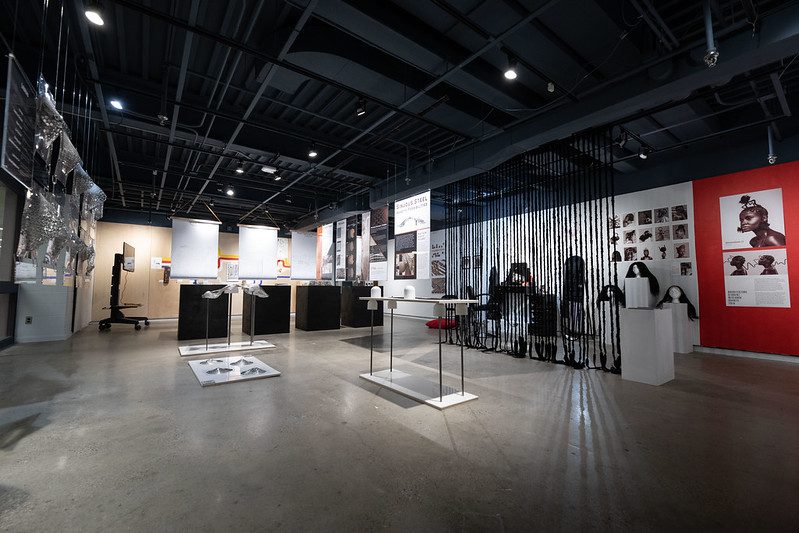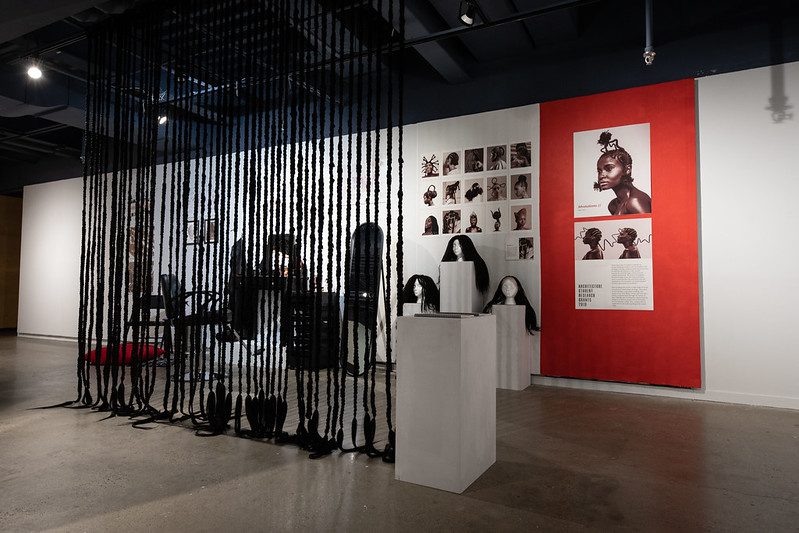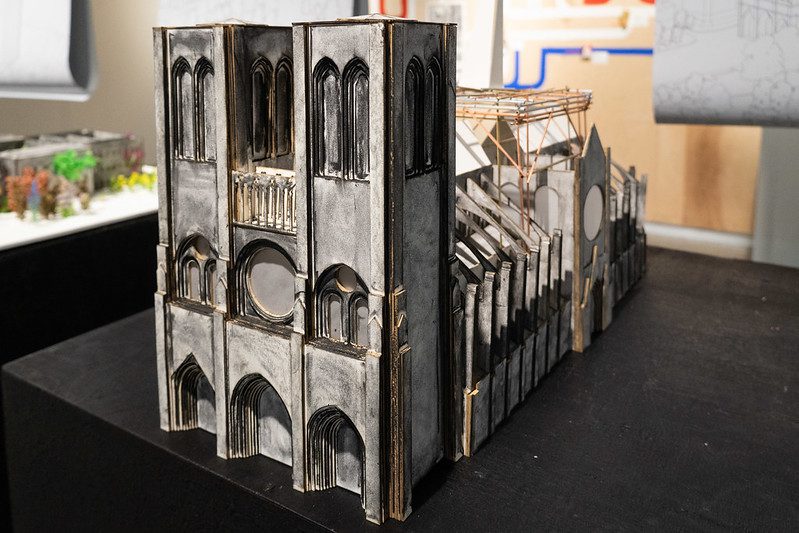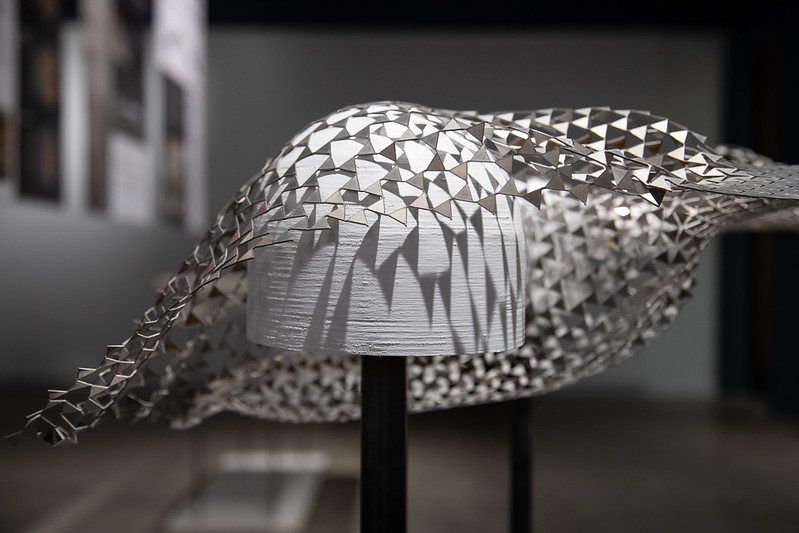
The 2019 Architecture Student Research Grant (ASRG) exhibition in the Taubman College Gallery features images of Grenfell Tower and Notre-Dame Cathedral on fire, a series of raised steel domes with a sign encouraging people to step on them, and a row of floor-to-ceiling hair braids. It’s fitting, given that the ASRG calls for projects that push the boundaries and possibilities of the discipline of architecture, including new forms and methods of working, making, and representing.
“Taubman College is committed to the idea that architecture is a cultural product that always negotiates a complex plurality of voices and ideas, as well as myriad social, political, and aesthetic concerns,” said McLain Clutter, chair of the architecture program. “We look for alternatives and explore how architecture can inspire, improve, and involve our world and society. The Architecture Student Research Grant is an excellent example of our experimental mindset in action.”
The Architecture Student Research Grant, which was seeded with gifts from the Class of 2013 and continues to be funded through the generosity of Lisa Sauve, M.Arch ’11, M.S.’14, and Adam Smith, M.Arch ’11 (Synecdoche Design Studio, Ann Arbor), provides a unique opportunity for students to support outstanding research by their peers. The benefits for the recipients are many. “On a personal level, receiving an ASRG was the confidence boost I needed as I am beginning to understand and define my interests within architecture,” said Asya Shine, M.Arch ’20, who received a grant for “Afrotutions.” “Culturally, receiving an ASRG was an opportunity to showcase an underrepresented community within architecture, and hopefully create a familiar experience for other students of color at Taubman College.”
The 2019 recipients are:
Afrotutions
Asya Shine, M.Arch ’20
Afrotutions aims to inspire a strategy for design thinking rooted in African tradition that reimagines design aesthetics and communication. It celebrates the identity of Afro-people around the world through a historical and cultural framework. The project investigates the broad range of practices and techniques used to maintain Afro-hair and showcases the implications of a traumatic yet inspiring past rooted in generations of tradition. Hair braiding interweaves a wide range of social and physical relationships: heritage, expression of individuality, community building, and means of survival. Black women and men have always communicated through the beauty of hair. Globally, hair braiding has transcended the diaspora of African people, and its formation as an institution within Afro-communities is important in our understanding of the world today.

What was your inspiration for “Afrotutions”?
“My inspiration for Afrotutions began in the winter of 2019 in Claudia Wigger’s propositions studio, where I was studying how people in Lagos Nigeria, lived and worked. What I found most interesting in my observations were the vast circumstances in which Lagosians were doing hair — on the street and between buildings — and this familiarity inspired my desire to learn more about the origins of braiding.”
Who was helpful to you in developing your idea further?
“My faculty advisor, Claudia Wigger, was extremely helpful in guiding me throughout the entire process, from applying for the grant to the final exhibition. She helped push my thinking of what “architectural research” was and deepened my interest in historical and cultural research in architecture.”
Four Fires
Daham Marapane, M.Arch ’20, and Michael Ferguson
Fire and architecture are intimately intertwined: from prehistoric homes built around the hearth to the massive urban reconstructions following catastrophic fires in the modern era — the history of architecture is also a history of the management of fire. Four Fires looks at recent blazes in Oakland (the Ghost Ship warehouse), London (Grenfell Tower), Rio de Janeiro (National Museum of Brazil), and Paris (Notre Dame Cathedral). How did these fires start? What was consumed in their flames? What factors — technical, social, political — allowed them to burn the way they did? How will they be remembered? What agency and responsibility does architecture have in the prevention, mitigation, and cultural memory of catastrophic fire?

How did you come up with the idea for “Four Fires”?
“We were already thinking about architecture as histories of the material and political organization when the Notre-Dame Cathedral in Paris caught fire in April. The instant media frenzy (How did it happen? Who was responsible? What will rebuilding look like? Who will pay for it?) led us to think about other prominent fires in recent memory and the deep social, cultural, and technical forces underpinning what’s on the surface seem like such chance disasters.”
Who was helpful to you in developing your idea further?
“Daniel Jacobs and Liz Gálvez both provided key advice and input throughout the project, pushing us to look seriously at both the legal, political abstractions of fire but also its deep physical and material reality all at the same time. This tension between the sort of distanced analytical view and the realities of flame, char, and smoke was central to our final project.”
What does it mean to you to receive an ASRG?
“It’s a privilege to have the time and institutional support to do a project like this, and for that, we’re particularly grateful to Taubman College and Adam Smith and Lisa Suave at Synecdoche design, who fund the ASRG work. Our interest in this sort of historical, analytical project and how it informs contemporary practice will certainly stick with us going forward.”
Sinuous Steel: Auxetic Possibilities
Mackenzie Bruce, M.Arch ’20, and Maggie Cochrane, M.Arch ’20
This project explores the opportunities and limitations of auxetic patterning on steel sheets to create controlled doubly-curved surfaces. Auxetic patterns are created through nested geometries that create “hinge points”. When cut into planar sheet material, the surface is allowed to expand in multiple directions when stretched, rather than stretching parallel to the applied force. The resultant elasticity allows the material to be formed into unique forms beyond the typical capabilities of flat surfaces. We have interrogated the potential of this technique by combining fabrication technologies of the CNC Waterjet and 7-axis Kuka robot which allows for formal, spatial, and experiential explorations with greater material efficiency in the panel and form-making process. Our research involved an iterative process of experimentation of thin gauge steel sheets with various auxetic pattern geometries, sizing, and robotic tool heads that allow for the flexibility and control of the form. The research not only generates material prototypes but also incorporates automation with robotic processes for controlled localized surface deformation without the need for material-intensive molds. As a result, the steel gains qualities of visual permeation, airflow, and structural strength that are otherwise unobtainable in a sheet material of a thin gauge. This research gives insights into the material behavior of auxetic steel, a step toward the fabrication of architectural enclosures, furniture, structural elements, and other possibilities.

How did you come up with the idea for “Sinuous Steel”?
“We developed this idea in our Sartorial Architecture seminar with Tsz Yan Ng, where we were making textiles out of unconventional sheet materials. We were looking to make textiles that were flexible and supple; in investigating this, we found auxetic patterns into sheet material could get us this quality. For the course, we worked with PETG and melted it over a mannequin to study the way it can form to the curves of a body. This made us think about how we could apply this at an architectural scale, which is when steel came into play.”
Who was helpful to you in developing your idea further?
“We continued to work with Tsz Yan Ng as our advisor on this project, who was very helpful in giving us advice on how to best represent our project clearly and help us navigate the process of applying and fulfilling a research grant.”
What does it mean to you to receive an ASRG?
“It is quite an honor and a great opportunity for us. At the end of Sartorial Architecture, we had an interest in continuing to work on this project, but for a number of reasons, we didn’t think we would be able to. This grant gave us the chance to continue to explore auxetic materials and their architectural applications.”
Learn more about the Architecture Student Research Grant and past winners here.





